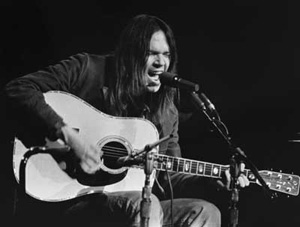YOUNG, NEIL (b. 1945)

Neil Young, singing
View largerNeil Young's forty-year career has established him as one of the most productive and influential folk and rock musicians in North America. Young was born in Toronto, Ontario, on November 12, 1945, the son of Scott Young, an acclaimed Canadian sportswriter. When his parents' marriage dissolved in 1960, Young moved west to Winnipeg, Manitoba, with his mother, Rassy. It was in Winnipeg that the adolescent Young became a musician, first nurtured at the piano of his talented and progressive mother and later plugging in an electric guitar when rock and roll emerged as a major musical genre.
Growing up in Winnipeg, Young felt not only the pop influence of the British Invasion and the lyrical focus of folk music but also the strains of rockabilly and country twang that blew in from the Prairies. Young spoke of his modest Winnipeg upbringing during a 1999 concert in Minneapolis, noting, "I grew up a bit north of here. This was the Emerald City to me." After playing in several high school bands in Winnipeg, Young sought to advance his career first in Fort William and Toronto before heading west to California in 1966. There he joined the folk rock band Buffalo Springfield, and he has been one of rock's stars ever since.
With more than fifty albums to his credit, Young has embraced many musical styles and performed with a diverse assortment of collaborators, yet two particular sounds stand out: his acoustic compositions, which date back to his folk music days in Canada, and the bold electrical offerings created with his longtime backup band, Crazy Horse. Young's acoustic songs blend his distinctive highly pitched vocals with multilayered guitar chords punctuated with bass runs. Young adds a plaintive harmonica to many of his acoustic songs and provides competent backup on the piano and an antique pump organ. When backed by Crazy Horse, Young's music takes on a different personality, with a powerful guitar sound that is part Americana, part blues, and part grunge. Young's electrical guitar roams freely over the music with full, rich chords and piercing solos. Young is a superbly accomplished guitarist whose mastery is best appreciated in live performances.
Young's songs are often composed of fragmented phrases and juxtaposed verses that seldom stand alone as poetry yet when combined with his music take on an evocative meaning that transcends words. An example of this is Young's "Ohio." Written in 1970, the day after National Guard troops killed four protestors at Kent State University and recorded with Crosby, Stills and Nash, the song hit the airwaves within a week of the shootings and became an instant anthem for the antiwar movement. Young had been reluctant to embrace the antiwar cause to the extent of many of his folk music contemporaries, and his later political sentiments were as scattered as his musical styles. Still, his songwriting expertise is evident in this minimalist song that so well captures the heart and soul of the matter.
Young's rural roots and populist tendencies are evident in his passionate involvement in Farm Aid, an annual concert event initiated in 1985 with fellow musicians Willie Nelson and John Mellencamp. Young's commitment to this cause is evident in his extensive onstage discourses on the plight of family farms. This is a marked departure from his usual stage demeanor, which is intensely focused on his music and seldom includes more than a few obligatory greetings thrown in between songs. With two sons suffering from birth defects, Young and his wife, Peggi, have also organized the annual Bridge concert since 1986, supporting a San Francisco-area school for severely handicapped children.
Young has twice been inducted into the Rock and Roll Hall of Fame, first in 1995 as a solo artist and in 1997 as a member of Buffalo Springfield.
Sean Hartnett University of Wisconsin-Eau Claire
McDonough, James. Shakey: Neil Young's Biography. London: Random House UK, Limited, 2002.
Previous: Wills, Bob | Contents | Next:
XML: egp.mus.053.xml
